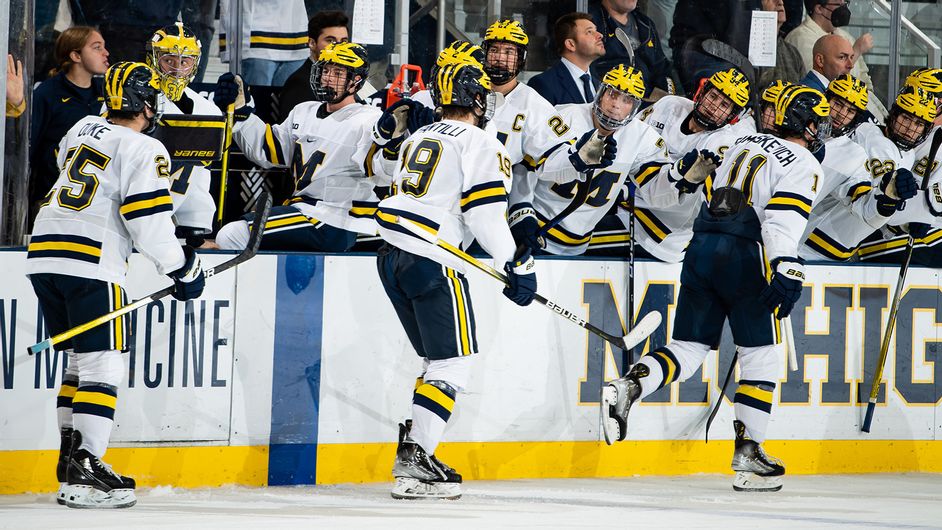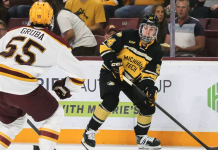
Each week during the season, we look at the big events and big games around Division I men’s college hockey in Tuesday Morning Quarterback.
Dan: Happy Tuesday, everyone, and welcome inside the battle room here for a Massachusetts-based edition of this week’s TMQ. Pleasure to be riding alongside Jimmy this week to break down what was an insane weekend of college hockey.
As expected, the marquee matchups offered little to no disappointments. Minnesota and North Dakota split two playoff-type atmospheres reminiscent of the old days when these were conference games. St. Cloud beat Minnesota State and refuted the “St. Cloud hasn’t beaten anyone” theory from before the weekend. Quinnipiac split at Maine. Michigan did Michigan things, and Denver did Denver things.
The rankings that were released this week reflected those wild and crazy times. Minnesota remained No. 1, but the next 10 teams changed spots, with St. Cloud jumping into the fray with an undefeated 6-0-0 record and 14 first-place votes. I’m one of the folks who jumped on the St. Cloud bandwagon, buuuuuut (drawn out for dramatic effect) there are tons of factors other than simple numbers involved here, I feel.
Jimmy, first thoughts when you saw the rankings?
Jim: Well, I think the top of the poll feels a little off to me. You have a two-loss Minnesota team ranked No. 1 while North Dakota, a team that was seconds away from a two-game sweep of the Gophers this weekend, is all the way down in sixth. To me that seems like a disconnect.
I have a difficult time having a two-loss team at the top when you have others teams without a loss playing some excellent hockey. UMass just manhandled Union twice this weekend and comfortably swept Denver a week ago. St. Cloud State is a perfect 6-0-0 and just swept Minnesota State and Wisconsin (two wins that look better after the Badgers sweep of Minnesota Duluth). I can even make a case for Michigan at this point to be No. 1.
But that’s why there are 50 voters and I’m just one voice.
Speaking of Minnesota Duluth, I’m not surprised to see them free fall down to 19th. Honestly, you could probably make a case to not even rank the Bulldogs are being swept by Wisconsin and Minnesota State over the last two weekends, being outscored 16-3 in those games. I know it’s early but is it time to sound the alarm on a team that many thought should challenge Denver and North Dakota for the top spot in the NCHC?
Dan: Nope, and there are a few good reasons for it.
Make no mistake, UMD had a bad weekend against an opponent we all believed it would handle with ease, but I don’t think the performances are as indicatively bad as our brains want to tell us. Wisconsin played well against both Ohio State and St. Cloud, and even though there weren’t wins, three out of four games against teams that have a case for a top ranking is exactly the kind of winless record primed for a breakthrough. I think the wins are more of a compliment to a Wisconsin team that we all doubted more than a knock against Duluth.
That said, what happens moving forward is the real key for that program. This is a sneaky tough weekend against Cornell this week, and next weekend at Colorado College is against a team that’s historically been a beatable program. If there are too many slips over those two weekends, then I think we can start writing the Bulldogs into the next tier of NCHC teams. There is no way, in my mind, they can head into the November stretch against Omaha and Western Michigan with too many losses in hand, especially since they haven’t touched the Denver-St. Cloud-North Dakota portion of the schedule.
In short, I don’t have warm fuzzies, but I’m not panicking.
Turning our attention back here to our homefront, I was surprised that UMass Lowell barely moved the needle in the rankings after beating Northeastern on the road. That felt more of an indictment of the Huskies than an endorsement of the River Hawks, but truthfully, it was a fantastic hockey game.
I know you had a front-row seat to that one, but I remain surprised that more people aren’t taking stock of how competitive these games are becoming on the eastern front. Hockey East in particular is getting deeper and deeper as the season moves forward, and I count at least six teams off the top of my head – UMass, Northeastern, PC, BU, Lowell, even BC – as programs that I think have the tools and talent to rattle the cage this year.
Jim: You know, having been around Hockey East as long as I have, I think coaches in that league are okay with being a little disrespected by polls. There is a mentality that it is easier to simply not have a bull’s eye on your back.
That said, within Hockey East, I expect there to be an absolutely battle royale. Eight of the 11 teams in the league are either ranked or are receiving votes in the latest USCHO poll. Plenty of storylines and reason that multiple teams can win the league title and, in reality, you can expect a team that many might consider as a potential champion as a team that won’t even finish top four and get home ice.
And I know that many leagues believe that there is plenty of parity in their leagues. The Big Ten leads all leagues for intra-conference winning percentage with a likely-unsustainable .725 winning percentage. Much of that came from a perfect 7-0 record last Friday night.
But Hockey East is right on the B1G’s tail, at .667 (while the NCHC is third at .602). All three of those win percentages are solid and will result in a plethora of NCAA at-large bids.
But back to your original point. Yes, I think Hockey East is getting a little overlooked.
Your new beat, ECAC Hockey, will be playing with all 12 members beginning this weekend as the Ivies finally get underway. We could wax on about how annoying the delayed start to the Ivy schedule is, but I’d rather think about which teams from that side of the ECAC are the most competitive. Harvard and Cornell usually seem like the answer. Any additions you would make?
Dan: If we’re looking at national contenders, I think the list stops there until ECAC can build its way back to a third bid to the national tournament.
I’ve mentioned this a couple of times, but Harvard’s tournament championship avoided a disaster scenario for the league where it only had one bid for the first time in forever. Though it should be noted that, in some ways, Harvard’s win knocked Clarkson off the bubble, though some funky math did that when the Golden Knights finished 16th in the Pairwise Rankings.
Let’s double back to the rest of the Ivy League, which is in its second year of the post-pandemic rebuild. If we’re looking strictly at the other four teams other than Harvard and Cornell, none of them jump off the map as contenders. Brown has to find some scoring after losing the majority of its offensive production, and Yale and Princeton both need some things to go right before we count them among the middle tier of the conference. Dartmouth is an intriguing option, but the Big Green would have to catch some teams that are further ahead as the season started.
ECAC has openings because the league is so top heavy, but Clarkson’s bad start coupled with RPI’s better-than-expected start has things jumbled when it comes to jumping into the mixer. I can’t see Clarkson staying down, and I predicted RPI would finish in the lower four. That means something else has to happen with those Ivy schools that, as the year begins, is pretty difficult to predict.
I will say this – one of those schools is going to ruin someone’s season, and it’s probably going to happen early. Harvard has Dartmouth and Princeton this weekend, and a loss now could come back to haunt someone in the hunt for the postseason. Other than that, it’s going to be the same old teams.
It’s honestly a little frustrating to me, though I know the onus is on the on-ice production of other programs, but it feels like even the start of this year is steamrolling towards the same teams factoring into the national tournament race. As of right now, it’s the Michigan-Quinnipiac-UMass-Minnesota State-name your school that’s usually in the tournament, and with the exception of Minnesota-Duluth, we’re maybe seeing the reemergence of a BU or the emergence of a UConn.
I’m trying to think of the last time we saw an honest-to-goodness breakout. With the exception of UMass’ title in 2021, which came on the heels of its loss to Minnesota-Duluth in 2019, we haven’t seen a new national champion since Providence’s title win in 2015. We had that glorious three-year stretch when we crowned new national champions in Yale, Union, and PC. Minnesota Duluth was right there in 2011, and even RIT’s Frozen Four appearance in 2010 signaled the start of something new.
We’re seeing mini-flares every now and then (AIC’s win over St. Cloud rings in my ears), but what’s going to take, in your mind, to get some new names into the mixer? I feel like the days of Cinderella just aren’t there anymore, though I know that’s an incorrect statement even as I make it.
Jim: While I understand that it might be difficult to find your next Cinderella, especially if you consider a first-time national champ to be what defines that category, it might be difficult to find.
We’ve seen some teams knocking on the door. UMass Lowell has been one of the most consistent teams in Hockey East for a decade, though still has just a single national tournament. Western Michigan is another school that is on the upswing of late. Arizona State is another club I look at as always being in the national picture.
Oh, and let’s not forget another “new” program in Penn State. The Nittany Lions may not have played world beaters at this point, but they are 6-0-0 and getting national consideration.
I don’t want to say that any of these teams are ready to knock off the world and win a national title, but any of them could pull of what Providence, Union and Yale did. Why not, right?


